Using a new dataset of online vacancies from India’s largest jobs website, Copestake et al. document near-exponential growth in the demand for artificial intelligence-related skills in the services sector since 2016, coinciding with the take-off in developed countries. They find that the demand for AI skills by establishments has a negative impact on labour demand for non-AI roles and on the top percentile of wages, driven by the displacement of high-skilled, managerial occupations and non-routine, intellectual tasks.
Advances in artificial intelligence (AI), driven by progress in the sub-field of machine learning (ML), have spurred an intense debate about the impact of AI on jobs. Yet despite widespread discussion, detailed empirical evidence measuring this impact remains limited. This is particularly the case for middle- and low-income countries, where little is known about the extent of deployment of AI and what it is being used for, let alone how it is affecting labour markets.
Emerging evidence from global job postings suggests that demand for talent with AI skills has taken off around the world (Figure 1). Among myriad implications, this is particularly important for countries pursuing a services-led development model. Many of the services industries that have driven growth and job creation, such as Business Process Outsourcing (BPO), are highly susceptible to ML-based automation. In India – the archetype of services-led development – the IT-BPO sector currently employs around 4 million people and contributes 8% of India’s GDP (SESEI, 2019). Indeed, revenues in India’s BPO sector have nearly tripled over the past ten years (NASSCOM, 2018). Any threats to employment in such sectors are a significant concern given the 200 million young people expected to age into the labour market over the next 10 years (United Nations, 2019).
Figure 1. Share of online job postings listing AI skills, by country
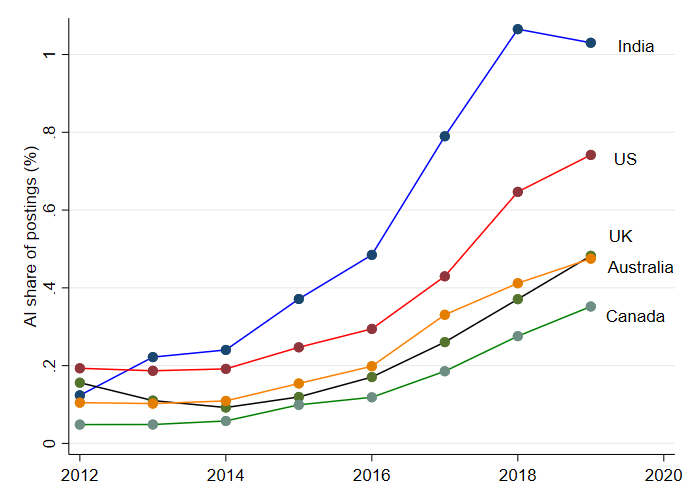
Notes: i) This graph shows the percentage of all online vacancies that specify particular AI skills, with these skills defined as described in the text. ii) Data for India is from Copestake et al. (2023); data for all other countries is from Lightcast, which does not cover India.
The theoretical impact of AI on jobs is ambiguous. Advances in ML have reduced the cost, or improved the quality, of the task of ‘prediction’, which is prevalent in many occupations (Agrawal et al. 2018). While these trends initially suggest the displacement of labour in favour of AI, improvements in the task of prediction could also expand labour demand by reducing overall costs of production or increasing quality, hence raising productivity. In addition, AI could complement human labour, create entirely new tasks, or incentivise changes in organisational structure; indeed, there is growing evidence that AI is a general-purpose technology (GPT), an “invention of a method of invention” (Brynjolfsson et al. 2017, Cockburn et al. 2018, Klinger et al. 2018, Goldfarb et al. 2020, Agrawal et al. 2021). Emerging economies like India could benefit from new global AI value chains, capitalising on their abundance of engineering talent, existing expertise in IT outsourcing, and further declines in communications costs (Baldwin and Forslid 2020).
Demand for AI skills in India’s services sector
In a recent study (Copestake et al. 2023), we investigate the labour market impact of AI in the white-collar services sector in India using a novel dataset of vacancy posts from the country’s largest jobs website. Following Acemoglu et al. (2020) and Stapleton and O’Kane (2020), we gauge firm-level AI adoption using demand for machine learning skills, as observed in the text of posted job descriptions. We see a rapid take-off in ‘AI demand’ (shorthand for the demand for AI-related skills in vacancy posts) after 2016, particularly in the IT, finance and professional services industries (Figure 2).
Figure 2. Share of online job postings in India listing AI skills, by industry
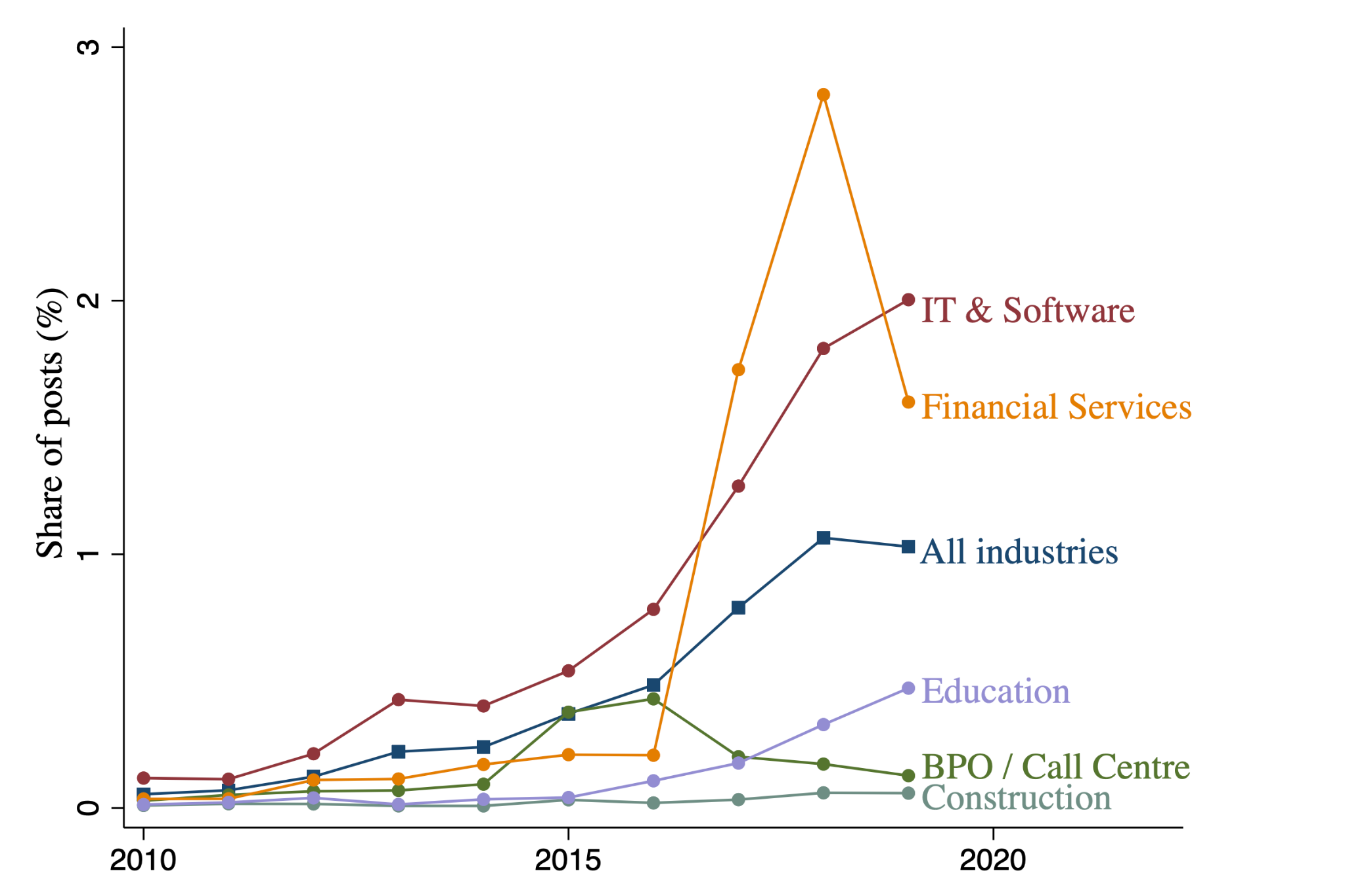
Note: This chart shows the share of all posts that are AI vacancies, both for all industries together and within each of the top five industries by AI share.
AI roles tend to require substantially more education, particularly graduate degrees, while also paying significantly more. Even after controlling for detailed region, industry, firm, occupation and role fixed effects, posts demanding AI skills still pay a 13 to 17% salary premium. Such roles are heavily concentrated in a few key technology clusters – particularly Bangalore, Mumbai, Hyderabad, Pune, Chennai and Delhi – and in the largest firms. Consistent with this spatial clustering, we find evidence of local diffusion: after the first firm in a given industry and region adopts AI, other firms in the same industry and region are, on average, more likely to start demanding AI skills, even after taking into account industry and region trends.
Impact of AI adoption on businesses’ demand for labour
We then turn to the impact of AI adoption on establishments.1 We first consider the short-term impact, using an event-study approach combined with propensity score matching2. Following Koch et al. (2021), we match firms adopting AI to similar firms that do not adopt AI, and examine the differences in their subsequent behaviour. We find that AI adoption initially coincides with a small increase in general hiring, but then reduces demand for non-AI workers over the next few years, such that the overall effect is substantially negative (Figure 3).
Figure 3. Non-AI hiring following AI adoption
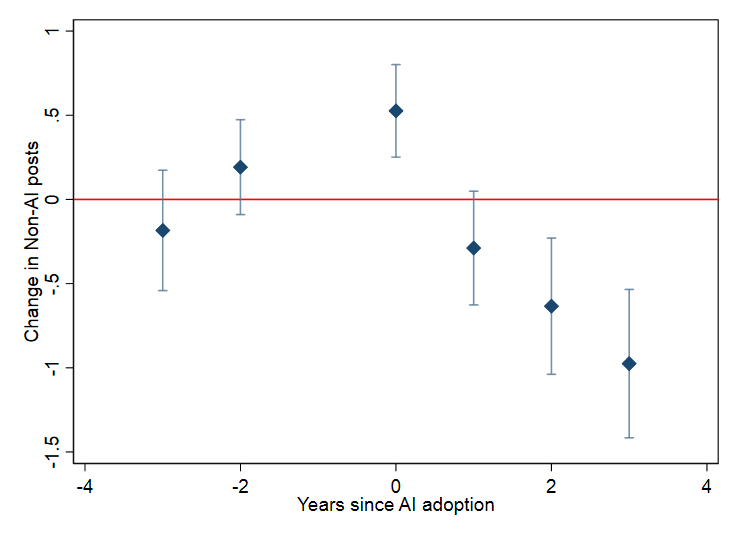
Note: We use an event-study specification with two-way fixed effects and a balanced panel. Adopters are matched to never adopters based on propensity scores from a Probit regression. Standard errors are clustered at the firm level.
To assess whether these impacts persist over the medium term, we examine the activity on the platform of large incumbent establishments (that is, those that posted both before and after the global takeoff in AI deployment in 2015-16). To isolate causation, we exploit pre-determined establishment-level variation in exposure to supply-side advances in AI capabilities, as reflected in the measure of Webb (2020), which captures the degree of overlap between occupations’ tasks and the tasks that patented AI technologies are designed to perform.
We find that firms more exposed to AI ex ante do indeed see a relative increase in their demand for AI skills in online vacancy posts (Figure 4), and this AI adoption then has a significant negative effect on growth in non-AI and total postings by establishments. Specifically, a 1% increase in the AI vacancy growth rate results in a 3.61 percentage point decrease in non-AI vacancy growth in establishments between 2010-12 and 2017-19, controlling for region, firm size and industry fixed effects. Growth in total establishment vacancies (both AI and non-AI) falls by a similar 3.57 percentage points, reflecting that the increase within the small set of AI posts is far outweighed by the displacement effect in the larger set of non-AI vacancies. Interestingly, these negative effects on vacancy growth are particularly strong for higher-skilled occupations such as managers and professionals.
Figure 4. AI share of all vacancies posted, by establishment exposure to AI (in quintiles)
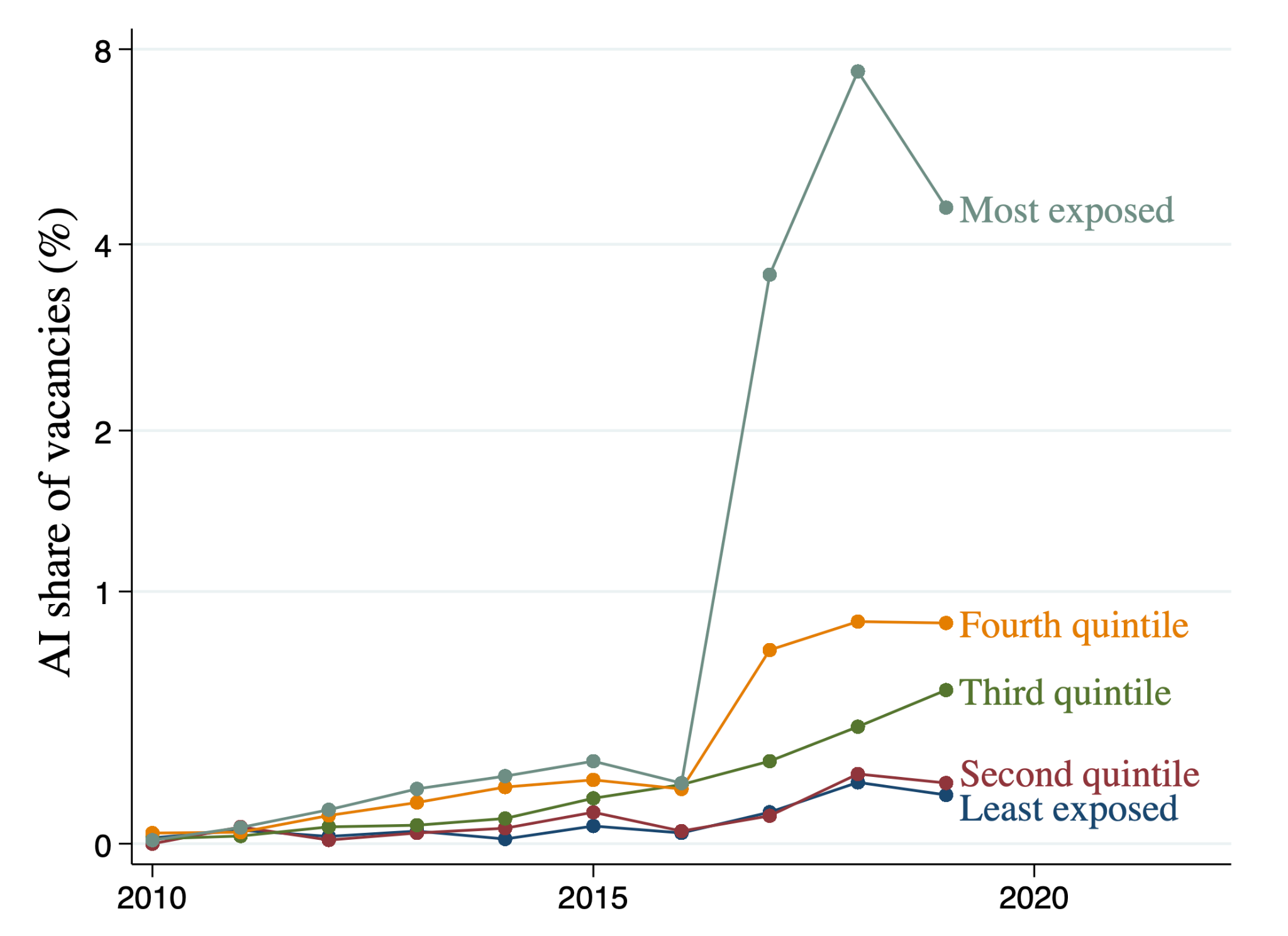
Notes: This chart shows the relationship between AI exposure, using the Webb (2020) measure aggregated to the establishment level, and the AI share of establishments’ job posts.
AI adoption also changes the pattern of demand for tasks. Increased AI demand in India reduces demand for occupations associated with non-routine tasks, and particularly so within higher-skilled occupations. To go deeper, we follow Michaels et al. (2018) by counting verbs in job descriptions and classifying them by meaning using Roget’s Thesaurus3. We find that AI demand reduces demand for verbs related to ‘intellectual faculties’ – in particular, the frequency of verbs associated with forecasting, analysis, and complex communication falls (Figure 5).
Figure 5. Impact of higher AI hiring growth on verb usage in job posts, by class
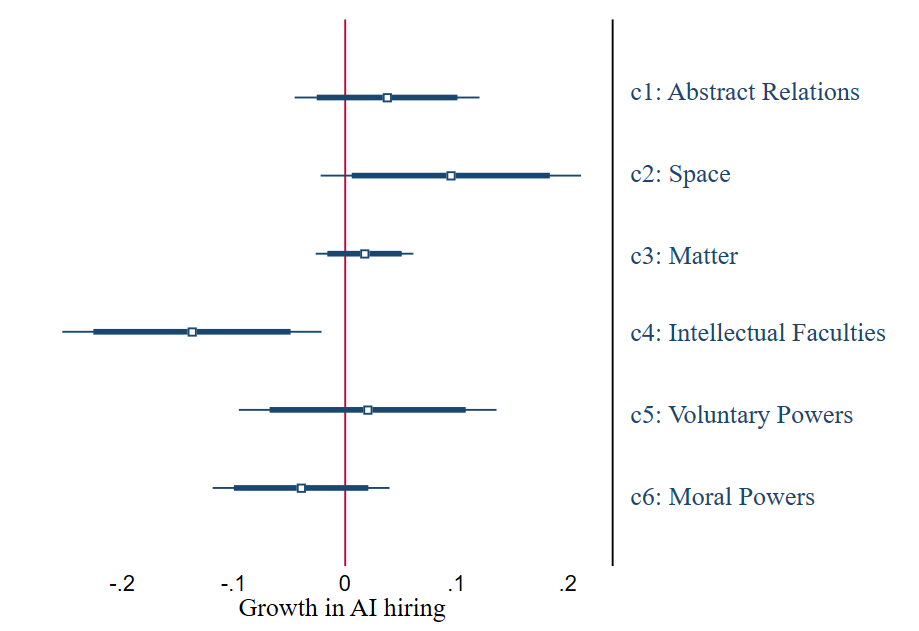
Notes: i) This coefficient plot shows the impact of increased AI demand between 2010-2012 and 2017-2019; each coefficient represents the percentage point impact of a 1% higher growth in establishment AI demand on verb share growth ii) Point estimates are accompanied by 95% (bold blue line) and 90% (blue line) confidence intervals. iii) AI demand is instrumented with AI exposure, standard errors are clustered at the firm level, and we include region, firm decile and industry fixed effects.
Impact of AI adoption on wage offers
How does this reduction in labour demand affect wage offers? We find that a 1% higher establishment growth rate in AI vacancies reduces the growth rate of non-AI median wage offers by 2.6 percentage points (again, instrumenting with AI exposure and controlling for region, firm size and industry fixed effects). As with vacancy growth, the negative effects of AI demand on wage growth are very similar when considering all posts, inclusive of AI vacancies. This decline in median wage growth primarily reflects the changing occupational composition, as the relative frequency of skilled managerial jobs declines: when controlling for occupation shares, we find that only the top percentile of wages declines significantly.
Summary
We find that AI demand has significant negative effects on non-AI labour demand and wage offers at the establishment level in both the short and the medium term. These are driven by the displacement of demand for high-skilled occupations and non-routine, intellectual tasks. Thus, our findings highlight the ‘double-edged’ impacts of AI: although AI jobs pay a substantial wage premium, these opportunities are highly concentrated, inaccessible to most workers, and displace demand for non-AI roles.
The views expressed in this column are the authors’ own and should not be ascribed to any of the institutions with which they are affiliated.
Notes:
- In this study, establishments are defined as firm-city pairs.
- Propensity score matching involves estimating each establishment’s probability of falling into the ‘treatment’ group (in this case, the group adopting AI), and matching treatment establishments with control establishments having approximately equal probabilities.
- Roget’s Thesaurus is organised into six classes – the first three (c1-3) cover the external world, including ideas such as numbers, shapes and sizes, and the five senses; the last three (c4-6) respectively relate to the mind, volition, and emotion.
Further Reading
- Acemoglu, D, D Autor, J Hazell and P Restrepo (2020), ‘AI and Jobs: Evidence from Online Vacancies’, NBER Working Paper 28257.
- Agrawal, A, J Gans and A Goldfarb (2018), Prediction Machines: The Simple Economics of Artificial Intelligence (illustrated edition), Harvard Business Review Press, Boston, Massachusetts.
- Agrawal, AK, JS Gans and A Goldfarb (2021), ‘AI Adoption and System-Wide Change’, NBER Working Paper 28811.
- Baldwin, R and R Forslid (2020), ‘Globotics and Development: When Manufacturing is Jobless and Services are Tradable’, NBER Working Paper 26731.
- Brynjolfsson, E, D Rock and C Syverson (2017), ‘Artificial Intelligence and the Modern Productivity Paradox: A Clash of Expectations and Statistics’, NBER Working Paper 24001.
- Cockburn, IM, R Henderson and S Stern (2018), ‘The Impact of Artificial Intelligence on Innovation’, NBER Working Paper 24449.
- Copestake, A, M Marczinek, A Pope and K Stapleton (2023) ‘AI and Services-Led Growth: Evidence from Indian Job Adverts’, Working Paper.
- Goldfarb, A, B Taska and F Teodoridis (2020), ‘Could machine learning be a general purpose technology? A comparison of emerging technologies using data from online job postings’, SSRN Scholarly Paper ID 3468822.
- Klinger, J, J Mateos-Garcia and K Stathoulopoulos (2018), ‘Deep learning, deep change? Mapping the development of the Artificial Intelligence General Purpose Technology’, arXiv:1808.06355.
- Koch, Michael, Ilya Manuylov and Marcel Smolka (2021), “Robots and Firms”, The Economic Journal, 131(638): 2553-2584.
- Michaels, Guy, Ferdinand Rauch and Stephen J Redding (2018), “Task Specialization in U.S. Cities from 1880 to 2000”, Journal of the European Economic Association, 17(3): 754-798. Available here.
- NASSCOM (2018), ‘Facts & Figures’.
- SESEI (2019), ‘Indian ICT Sector Profile Report’, Technical report, European Commission.
- Stapleton, K and L O’Kane (2020), ‘Artificial Intelligence and Service-sector Offshoring’, Unpublished manuscript. A version of this paper is available here.
- United Nations (2019), ‘World Population Prospects, 2019’.
- Webb, M (2020), ‘’, SSRN Electronic Journal.




 19 April, 2023
19 April, 2023 







Comments will be held for moderation. Your contact information will not be made public.